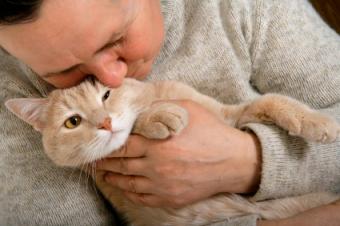
It's a good idea to be aware of the symptoms of the feline leukemia virus and discuss your concerns with your vet. From visible signs like weight loss and enlarged lymph nodes to more subtle indications like weakness and lethargy, this deadly disease makes it presence known in a variety of ways depending on the stage of the illness.
Early Symptoms of Feline Leukemia
In the first few weeks of infection, the cat's symptoms will probably be mild. Some of the things to look for are:
- Lack of activity or loss of energy
- Swollen lymph nodes
- Fever
General Symptoms
As the disease progresses, the symptoms of feline leukemia (FeLV) will increase. It will be more obvious that your cat is ill. The ongoing symptoms of FeLV will include the early symptoms that were listed above, as well as:
- Anemia
- Blood in the stool
- Recurring infections
- Loss of appetite
- Decreased energy
- Depression
- Changes in bowel habits
- Excessive drinking and urination
- Infertility

- Jaundice
- Weight loss
- Eye problems
- Nerve problems, possible paralysis
- Arthritis
- Dehydration
- Difficulty swallowing
- Poor coat
- Loss of gum color
- Fluid in the chest
- Coughing
- Gagging
- Tumors
- Ulcers at the openings of the body:
- Mouth
- Nostrils
- Anus
- Vagina
- Eyes
Like many humans with auto-immune disorders, cats with feline leukemia will have periods of good health followed by periods of difficulty. Since there is no cure, it is important to keep your pet as comfortable as possible. Talk to your vet about pain management techniques to keep your cat comfortable.
Symptoms in Pregnant Cats
The symptoms of FeLV in pregnant cats are identical to the above. A queen may not carry her litter to term and may experience either disintegration of the fetus or spontaneous abortion.
The kittens may also show effects of the virus. Often, kittens born to an infected mother will die within a few weeks of birth. Symptoms you may see in kittens that have been exposed in utero are:
- Stunted growth
- Bacterial and viral infections
- Lack of appetite
- Wasting away of the thymus gland
- Increased susceptibility to secondary bacterial and viral infections
FeLV and Cancer
About thirty percent of all cats that get feline leukemia will develop cancer. Some things to look for include:
- Cloudy eyes
- Diarrhea
- Liver damage
- Kidney damage
- Respiratory problems
- Vomiting
How is FeLV Spread?
Feline leukemia is spread in several ways through contact with infected:
- Saliva
- Mucus
- Urine
- Feces
- Blood
What this means is that in a multi-cat household, the normal hissing, grooming or shared water bowls may all contribute to the transmission of the disease. Shared litter boxes and food bowls will carry the virus from one cat to another as well.
How is FeLV Diagnosed and Treated?
When a cat is presenting symptoms of feline leukemia, there are a couple of tests that the vet can run to get a positive diagnosis. This includes:
- Elisa Blood Test
- Elisa Mucus Test
- IFA Blood Smear
Unfortunately, there is no real treatment for this disease. All medications are aimed at making your pet as comfortable as possible and relieving pain and anxiety. Your vet will prescribe antibiotics to handle any secondary infections caused by the FeLV. He or she may also schedule chemotherapy if your pet is suffering from a cancerous form of the disease. Mainly, your will monitor your cat's health for changes from week to week.
Since inside cats are at less risk than outside cats, consider keeping your cat in the safety of your home. Vaccinations are available for FeLV. While not one hundred percent effective, they are helpful.
Watch your cat for signs of the disease, and always test new cats before they are allowed to come into your house. Keep your pet as safe as possible.







